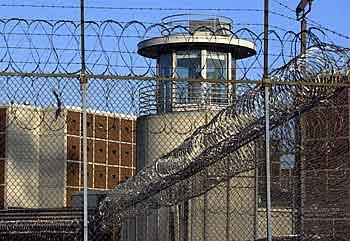How the Right Changed Its Mind on Imprisonment: Megan McArdle

published Oct 20th 2016, 2:12 pm, by Megan McArdle
(Bloomberg View) —
One of the heartening developments of the last few years has been the emergence of a serious movement for prison reform on the right. These people are not simply coming over to the left-wing side; they have their own ideas about de-escalating mass incarceration, and an increasingly serious commitment to doing so.
Political scientist Steven Teles has just released a new book on the phenomenon: “Prison Break: Why Conservatives Turned Against Mass Incarceration.” I sat down with him on Thursday to ask him about the book and talk about what it might mean for the future of both criminal-justice reform and the Republican Party.
Megan McArdle: Criminal-justice reform — in the sense of moving folks out of prison, instead of sticking more of them in there — is not what one traditionally thinks of as a Republican core issue. Why did you decide to write a book on it?
Steven Teles: First of all, I want to acknowledge that I have a full co-author on the book, my graduate student David Dagan. So I’ll just speak to my motivations here, because David’s are different.
I’ve always been interested in conservatives, and have spent most of my career thinking about them. My first book, “Whose Welfare?”, spent a great deal of time on conservative strategizing to reform welfare. My last big book, “The Rise of the Conservative Legal Movement,” was all about how conservatives attempted to countermobilize against legal liberalism. So I started out with a lot of connections among conservatives and libertarians, and a curiosity about them that is somewhat unusual in the academy.
More specifically, I’m really interested in why people change their minds, which is what I think the real macro-story in the book is. In political science we often model political actors as having fixed interests and positions, and then we try to figure out how they do or don’t get their way. But there’s actually more play in the joints of politics than that. Some people — like Ronald Reagan! — just switch teams entirely. More broadly, as we address in the book, entire parties switch their positions. If we want to understand politics, we need some way of understanding that process.
Many readers have not yet read your book, though everyone should, because it’s excellent. Can you give them a sense of how big a shift there has been in the conservative movement on crime?
Well, an awful lot depends on how you define “big shift.” There are two ways to do that, which are changes in positions and changes in actions.
On positions, there’s been a huge shift. Not much more than a decade ago, the pretty-well-consensual conservative position on crime was hard-line: longer sentences, stricter policing, unquestioning defense of what goes on in prisons, and so forth. Today there’s a very wide swath of conservative politicians who feel entirely comfortable taking positions in the opposite direction.
One example sort of makes the point. When Texas made its big criminal-justice reform in 2007, which kicked off the process of state-level reform, Governor Rick Perry had to be pulled into supporting it — he had opposed a similar reform just two years before. By the time he ran for president in 2016 (remember that?), he was advertising how wonderful the “Texas Model” of reducing reliance on incarceration is, and using the issue to show that he was a different kind of Republican.
Perry is now part of a huge group of conservatives who are part of the “Right on Crime” movement. This shows you how broad the change in position-taking is.
In terms of change in policy, on actions, it’s variable — both between states and between the states and the federal government. Our argument is that you tend to see really big reforms, and more significant change in positions, in states where Republicans are solidly in the majority.
In Texas, Georgia, Mississippi and other bright red states, Republicans have now done multiple waves of reform. Our explanation is that once Republicans really take over a state lock, stock and barrel, they don’t need the crime issue to beat up on Democrats anymore. So that gives them an ability to step back and look at the issue more analytically, and to reflect on whether their political values really support spending so much on prisons.
By contrast, in states like Virginia, lots of Republicans in the state legislature sound like they haven’t changed at all since 1988 — because in purple states, they’re just very hesitant to give up on an issue that might get them some electoral juice.
Finally, at the federal level, you see even less change. There are Republicans, like Mike Lee and Rand Paul, who support reform, and there are more than there used to be. But there’s less turnover in Congress than in state legislatures, and the political environment is even more polarized in D.C. than in most states, so the opportunities for gridlock are higher.
There’s an old joke that “A conservative is a liberal who’s been mugged, and a liberal is a conservative who’s been arrested.” How much did folks like Chuck Colson matter in getting this reform off the ground?
They mattered an enormous amount. Here’s how Dagan and I talked about this in the book: Colson was on this issue in a general way long before there was any change in the structural conditions that permitted reform to happen. He, along with fellow ex-con Pat Nolan, were on this issue when the context was very dark. But they created what the sociologist Verta Taylor called an “abeyance structure” — an organization that could keep the idea going even when the environment was not hospitable, so that the ground was prepared when it changed.
The other thing that Colson did is lend his very substantial credibility in the conservative movement to the cause. In a highly polarized environment, the person who can do the job of “identity vouching” is the one who, apart from the issue where you’re trying to change minds, is the most orthodox.
Because Colson was so far right on issues like abortion and the role of women, no one suspected him of being a secret squish more broadly. If he was saying that showing compassion for prisoners was the authentic conservative position, then that had to be taken seriously. There’s no pope in conservative evangelical Christianity, but Colson was close to that sort of stature — he was a major movement celebrity.
The other thing that Colson did is help lead thousands of evangelicals into prison ministry. Those people then had a personal connection to prisoners, and could tell stories to their fellow parishioners about what prisons were really like. I think that has sort of filtered through the movement, and helped push the issue up the agenda of evangelical politics.
My sense is that the reform wing of the Republican Party probably talks the most sensibly about crime. On the left, there’s a sort of mythology that mass incarceration is driven by nonviolent drug offenders. You make a point of noting that this is false: Half of all state prisoners (where the bulk of the population is) are in for violent crimes, and most people are in for things that most people think should carry jail sentences. Republicans seem to focus less on making these claims than the left, and more on things like rehabilitation and getting down the cost of prison. Is that fair?
So I think this is complicated — like most things in public policy! I think the big difference is that those to the left tend to think about the sheer scale of incarceration as itself an injustice. They look at the aggregate effects on less advantaged communities. That’s why the language of “mass incarceration” is so much more natural to the left (although you see some on the right using it, too).
Conservatives are less likely to think of the criminal-justice system as a whole as driven by systematic racial injustice. Most of the reformers come into this by way of bringing their positions on criminal justice into alignment with their positions on everything else.
Conservatives think that you can’t trust government, and if you can’t send its functions to the private sector, we need to impose things like metrics, measurement, targets and so forth to make it responsible. That’s conservatives on education, for instance.
But there was this big anomaly of the criminal-justice system, where that usual package of conservative reforms hadn’t been applied. So I think a lot of what states are doing are fairly obvious things that a conservative would do once you stopped thinking about the criminal-justice system as (like the military or the cops) being “your” part of government, and therefore not as subject to the machinery of control that you apply to things you don’t trust.
I think most of the people who are involved in the politics of criminal-justice reform know that the big increases in incarceration come from lengthening sentences (and probability of sentence) and not a massive expansion of drug crimes (although that’s very important at the much smaller federal level). But this is part of how most politics works — you start with the most sympathetic (and often anomalous) face for the issue, and then work from there.
But I agree with you, and we say it in the book — you only get prison rates much further down by reconsidering what sentence you give to murderers, rapists, armed robbers, etc.
And that’s very, very hard politics.
Politics that perhaps only Republicans can do, in the “only Nixon can go to China” sense?
Correct. We do think that conservatives are really important for the issue of criminal-justice reform, for two reasons. First, their involvement reduces the tendency of liberals to keep their head down and avoid the issue out of fear of electoral retribution.
But second, I think conservatives have something substantively important to add. Because they are more sensitive to the risks of reform, I think their engagement leads to more of an emphasis on controlling criminals outside the criminal-justice system — through what Mark Kleiman calls the “outpatient prison.” We’re only going to move the huge number of people we currently process through prison to the outside by building more effective systems of monitoring and control, like parole and probation.
My sense is that conservatives are more sensitive to the need for that system, whereas liberals are going to tend to focus on the importance of “reinvestment in communities.” But you need both.
You make the point early in the book that ideas are in large part about identity. As social psychologist Jonathan Haidt says, when an idea is congenial to your identity, people ask “Can I believe this?” When it’s opposed, they ask “Must I believe this?” Has “ultra-tough on crime” stopped being part of the Republican identity? And is that change broad, or is it only in red states?
In the book, Dagan and I phrase this point the following way: When people decide what position to take, the first question they ask is not “What is true?” but “What does a person like me think about this?” That is, they begin with identity appropriateness.
I think this makes a lot of stuff make sense. People, especially politicians, begin with a tribal identity. They know they are conservatives, or liberals, or whatever. They often have a lot emotionally and interpersonally invested in that identity. But beyond a few positions, they don’t always really know what that identity cashes out to in policy terms. So they look for cues from people with unquestioned authority within their tribe to help them fill in the blanks.
Twenty years ago, all the signals from the tribal elders were that being tough on crime was the identity-appropriate position for conservatives. In addition, the issue was working for conservatives, so you had self-interest added into the mix for working politicians. What’s changed — and the Right on Crime website gives you a sense of this — is a change in the signals from the top. This argument, by the way, fits with the important research by John Zaller that shows that public opinion largely is driven by elites.
Now, is the change broad or not? If you’d asked me this a year ago, I would have said it was broad and that the anomalies in some states were going to gradually be swept up in the national wave. There was a lag, because some folks like Charles Grassley came up in politics with the tough-on-crime position, but they were inevitably going to be replaced by people who got the more recent memo on what their position should be. And I do think that red states that are already well into a cycle of reform will stick with it — there’s no indication that Texas or Georgia, for instance, are wavering.
But I do think that the rise of Donald Trump is bad for the cause of conservative criminal-justice reform. You can see this, for instance, with Senator Tom Cotton, who many people think is going to pick up the mantle of populist conservatism from Donald Trump. Cotton blasted the bipartisan criminal-justice-reform bill currently in Congress, and his positions echo Trump’s, which are like Charles Bronson preserved in amber.
So, if I was to predict where this was going from here, I would say that this is going to be a part of the Republican civil war over the next few years. The Trumpites, like Cotton, will stick with opposing criminal-justice reform (as well as being hostile to any effort to reform police), and the reformers will stick with reform.
This also fits into very different theories of how the Republican Party should make itself electorally viable. The reformers think that they need to racially detoxify the Republican brand. To put it mildly, that’s not Trump’s strategy. That gets you very different implications about where the party should go. So I’d say that the actual content of what conservatism means on this issue, and many others, is starting to come unwound. You’re not getting the same kind of homogeneous signals from elites that you once were, and that’s a very unstable situation.
Where did this come from with Trump, do you think? Did he tap into voter discomfort with the direction that the reformers were going, or did he create sentiment that hadn’t really been there before?
That’s a great question. There are a couple of different ways of analyzing it.
First, I think there’s Trump’s very specific, personal history. Rick Perlstein has a great article about Trump’s grounding in a very specific New York conservatism. This was the New York of the ’70s and ’80s, where liberals had very little to say about rising crime and seemed to be sympathetic to its perpetrators. That generated the “tough outer-borough guy” style of conservatism, which has a variety of manifestations, including Morton Downey Jr. (whose similarity to Trump, aside from the smoking, is remarkable). So Trump comes clearly out of that tradition, and it explains the tropes that he draws on.
That said, there’s a second level of analysis, which is that in general Trump is separating himself most strongly from those issues where there’s been convergence between the parties. Trade, immigration, criminal justice, to some degree foreign policy — there’s a more internationalist, less authoritarian sort of set of positions where there’s a fair amount of overlap of the parties, even in our polarized era. Trump is cleverly exploiting that area of overlap by saying that the elites all agree on that stuff but it’s killing “the folks.”
That actually has a lot of similarity with the position-taking of parties like UKIP in the U.K. They take the positions where there’s an elite, cross-party agreement but latent popular hostility to draw on. Since we don’t have functional third parties, that phenomenon, which happens outside the party system in Europe, is now happening inside it, through party factions.
We’ve already talked about one threat to reform, which is Trump. How likely is it that that movement survives him, and what other factors might help decide that question?
In general, I think that there are two big categories of threat to reform.
The first is a change in the factional politics of the Republican Party. The anti-government, Koch-Ryan style of conservatism has all kinds of problems, but it’s great for reform. If the party really does become durably white nationalist, then it’s hard to see that liberals have a partner.
But the other risk is that the reforms being done in the states don’t work, or they simply run out of steam. There have been a lot of fairly technical changes that allowed states to pick the low-hanging fruit in terms of reducing incarceration. But in the major reform states, you’re running out of those, and getting prison numbers down requires that you build new institutional capacity, as I was talking about with prison and probation.
If you don’t do that — and conservatives may not want to do the long-term state-building it requires — I think you run up against hard limits as to how much reduction in incarceration you can get. Because I don’t think that relying on, for instance, therapeutic drug treatment and the usual array of services is going to get you the reductions in recidivism that we’d need to reassure citizens that we can cut prison numbers and crime together.
On the other hand, the rise of what’s been dubbed “carceral feminism” has created a sort of interesting dynamic. You’ve got feminists who are opposed to mass incarceration, but who want to relax due-process standards and impose much, much harsher sentences for sexual crimes (without condoning his alleged groping, I was shocked at the number of folks who seem to think that Trump should have gone to prison for it). That has pushed a lot of conservatives into making sort of classical liberal arguments about crime and due process. Could that be a countervailing effect, at least on the right?
Well, in a sense, this isn’t new. Marie Gottschalk discusses this in her book “The Prison and the Gallows.” Women’s groups were actually a part of the chorus arguing for stiffer sentences (they also wanted welfare-state-type interventions, too, but they only got the carceral stuff).
I do think the tendency to reach out for carceral responses to show our seriousness about any particular problem is still there, for sure. On the counterpressures to it, sure, you see some of that around campus sexual assault stuff. But I don’t think that is causing anyone to really rethink the scale of incarceration that we have.
The thing that, perhaps weirdly, has had that effect is white-collar crime, from finance to regulatory offenses. There are people like the Kochs who really, really care about that, and they’ve quite explicitly linked it to the drug war. I think that’s a really important linkage because there’s a connection to reducing the power of prosecutors.
As you look at the future of criminal-justice reform, are you hopeful or depressed?
Pessimism of the intellect, optimism of the will! I’m certainly more pessimistic than I was when the book came out. There are powerful forces threatening to repolarize this issue. We saw some of them when the book was completed, but they’ve become much more potent since then. This is true, by the way, on both sides. Black Lives Matter and the associated protests have had many important effects, but they have also created a strong incentive for conservatives to go to their corner, as the issue gets associated with protests, riots and the rest.
I think the sledding for conservative reformers from here on in is going to be much tougher, as the issue has more clearly become a part of a larger party factional conflict over the future of the Republican Party. I think the leaders of this movement really don’t want to get pulled into that, but I think they’re there whether they want to or not.
This column does not necessarily reflect the opinion of the editorial board or Bloomberg LP and its owners.
To contact the author of this story: Megan McArdle at mmcardle3@bloomberg.net To contact the editor responsible for this story: Brooke Sample at bsample1@bloomberg.net
For more columns from Bloomberg View, visit Bloomberg view
copyright
© 2016 Bloomberg L.P







No Comment